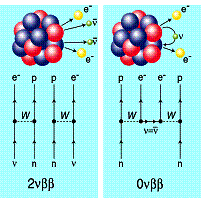|
|
Double Beta-decay
 Neutrino oscillations have been observed in
experiments with solar as well as atmospheric neutrinos. As a result, we know
that neutrinos are not massless as described by the standard model of particle
physics, but have a finite rest mass. However, oscillation experiments are
sensitive to mass differences between different neutrino flavours only, which
have been found to be in the order of 50 meV. In order to derive an absolute
neutrino mass, experiments on the nuclear double beta decay are carried out.
Neutrino oscillations have been observed in
experiments with solar as well as atmospheric neutrinos. As a result, we know
that neutrinos are not massless as described by the standard model of particle
physics, but have a finite rest mass. However, oscillation experiments are
sensitive to mass differences between different neutrino flavours only, which
have been found to be in the order of 50 meV. In order to derive an absolute
neutrino mass, experiments on the nuclear double beta decay are carried out.
The nuclear
double beta decay is an extremely rare radioactive decay mode where an isotope
changes its charge by two units while its number of nucleons is preserved.
Two reaction modes are at the center of attention, the neutrinoless and the
two-neutrino decay. The latter emits two electrons and two neutrinos. It is
allowed by the standard model and has even been directly observed in a number
of cases. Typically, half lives are in the order of 1019 years
(compare to the age of our universe which is about < 2x1010 years). The second
mode, in which no neutrino is emitted, is even more interesting. Here the
conservation of lepton number, a central postulation of the standard model, is
violated. Namely, electrons may not simply appear from nowhere, but for each
created electron (lepton number 1) an anti-neutrino (lepton number -1) is
needed to agree the balance.
The neutrinoless decay mode is usually described as two sequential ordinary beta
decays. The first one emits a neutrino, which is immediately re-absorbed by the
second decay. This is however only possible if neutrino and anti-neutrino are
identical particles, which in turn is allowed by the theory of weak interaction
if the neutrino has a rest mass!
Indeed, theorists have shown that the neutrinoless double beta decay half life of a
nucleus is directly connected with the neutrino mass. In other words, a
measurement of the half life would give us the neutrino mass! As such half
lives are expected to be extremely long (about 1028 years!),
measurements are a demanding challenge which has not been mastered yet.
At this point, one has to think about a further factor: the nuclear structure of the
involved isotopes. These so-called nuclear matrix elements are computed by
sophisticated model calculations. Some important matrix elements are also
accessible through experiments. A calibration of the model calculations on the
basis of such data is absolutely essential in order to obtain, in case of the
discovery of neutrinoless double beta decay, a precise neutrino mass out of the
eventually observed half life. Suchlike measurements are carried out by our
group at the accelerator insttute KVI in Groningen, where a setup was
installed which produces data with a worldwide unrivaled, unprecedented precision.
Links
KVI Groningen
ESN collaboration
|

